Mythical Creatures and Animals in Chinese Mythology, Folklore, and Legends
Mythical Creatures in the Classic of Mountains and Seas
Some ancient mythical creatures were documented in a book known as The Classic of Mountains and Seas, which is believed to have been written by Yu the Great, founder of the first empire, the Xia Dynasty (about 2070 BC — 1600 BC) in the history of China.
Yu the Great embarked on extensive journeys across various regions in China, leading his people in the battle against a colossal flood and triumphing over malevolent monsters.
He was not only an exceptional king and true hero but also an avid chronicler, recording the remarkable clans he encountered and the multitude of mythical creatures inhabiting those lands.

Mythical Creatures and Their Meanings in Chinese Culture
Over time, a wealth of mythical creatures has been discovered and chronicled within the realms of Chinese folklore and historical records.
From the eras of the Flame Emperor (Yan Di) and Yellow Emperor (Huang Di) to luminaries like Confucius and Dong Zhongshu, who officially endorsed the Interactions between Heaven and Mankind in 134 BC, it has been a prevailing belief that the appearances of auspicious creatures serve as harbingers of prosperous reigns and flourishing eras. Conversely, the absence of these creatures may indicate otherwise.
This profound belief has etched a significant mark on Chinese culture, as those legendary animals have become popular Chinese Patterns in clothing, jewelry, decor, and architecture, and have frequently been woven into the tapestry of literary works.
Among these legendary creatures, four stand out as particularly miraculous, benevolent, and auspicious: the Dragon (representing Variability), the Phoenix (symbolizing Knowledge), the Qilin (embodying Honesty), and the Turtle (associated with Divinity).
Dragon
In Chinese culture, there are many types of dragons. Most are brave, powerful, variable, insightful, invincible, intelligent, and caring about human beings.
Up in the sky, they are in charge of wind, thunder, and rain; down on earth, they control rivers, seas, and lakes.
Ying Long — Dragon of Earth and Power
Ying Long lies in the middle of the sky (Read the Other Four Mythical Animals Guarding on the Sky) and represents the earth in the Five Elements.
It controls wind and rain and is superior to other mystical creatures.
Therefore, the images of the yellow dragon with five claws were strictly and exclusively used by emperors in history.
In ancient books, Ying Long had assisted the Yellow Emperor (Huang Di) and Yu the Great and made distinguished contributions in defeating evil beasts and massive floods.
Unlike other dragons in China, Ying Long had two wings that later evolved into colorful clouds.

Zhu Long — Dragon of Time and Season
According to The Classic of Mountains and Seas, Mount Zhong is located in an extremely frigid place in the north.
On top of this mountain, a mighty dragon named Zhu Long, or the Dragon of Zhu, is living there.
Zhu Long has an over 500 kilometers long snake-shaped red body with a human’s head.
He is in charge of transforming time and weather and never eats or sleeps.
He brings the daytime by opening his eyes and takes darkness to the earth when his eyes are closed. His exhalation means the winter is coming, while inhalation brings summer to the world.
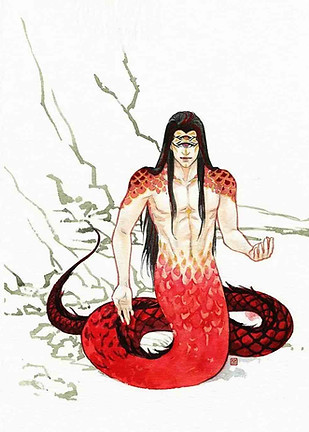
Chi Long — Dragon of Protection and Auspiciousness
Chi Long was originally an animal from the sea; after years of magical cultivation, it became a type of dragon that looks like a gecko with no horns.
The marine origin made Chi Long a good fighter against fire.
Unlike other strong dragons, Chi Long is closer to people’s daily lives, which makes it the symbol of luck, happiness, romantic relationships, and a promising career.
Therefore, its image was widely used in people’s clothes, accessories, and decorations.
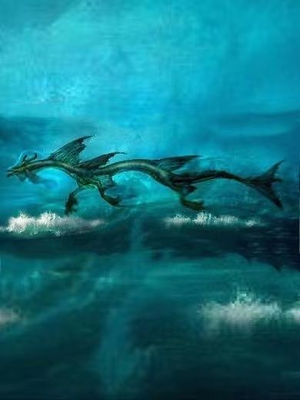
Jiao Long — Dragon of Transformation and Challenge
In mythical Chinese culture, animals like fish and snakes can transform into dragons if they have dragon blood or do remarkably good things like having saved people's lives or running into some special opportunities.
However, this transition takes a long time (hundreds or thousands of years), and they must face the risk of being interrupted or destroyed by other species or humans.
At the end of the transition, there will be a final thunder test: if they survive after being hit by the thunderstruck, they fly to the sky and become powerful immortal dragons.
Otherwise, they would be burnt to ashes immediately.
Jiao Long is the animal's name in the transition before the final thunder test, so they have scales and look half snake and half dragon. They cannot fly but swim incredibly fast and cause massive floods.
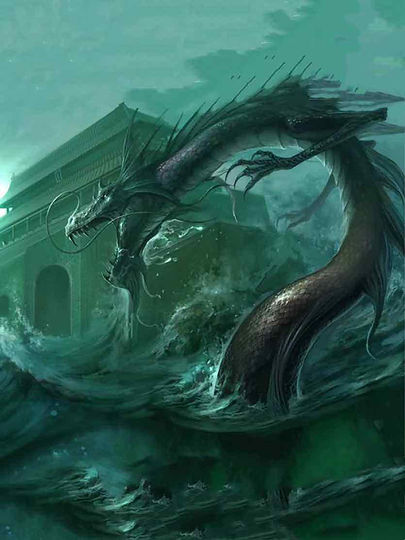
Qiu Long — Dragon before Adolescence
There are many different versions concerning Qiu Long’s looks, but the consensus is that Qiu Long is the baby or the teenage dragon.
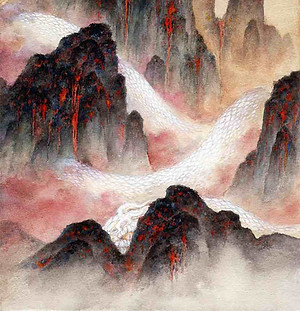
Qiu Long, Drawn by Shanze Li Yifan.
Pan Long — Dragon Coils on Earth
Pan Long has black skin and is over 13 meters long, and it usually coils on the ground or swims in the rivers or seas.
Pan Long is venomous but could bring rain to drought places.
Pan Long has been widely coiled in pillars and beams in ancient Chinese buildings, meaning to protect people living inside from any injury.
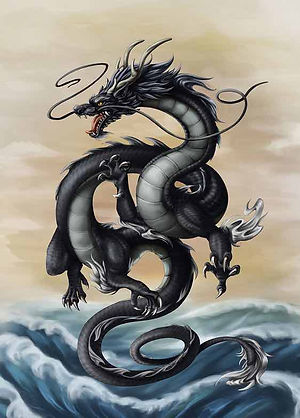
Chinese Phoenix or Fenghuang
Phoenix is a big, colorful bird with miraculous power whose feathers constitute five Chinese Characters: virtue, righteousness, courtesy, benevolence, and faith.
Phoenix lives in Phoenix Trees, eats fresh bamboo, and drinks from fresh springs. It never lives in a group nor goes to dirty, chaotic places.
During Yellow Emperor and King Shun’s reigns, it had been noted that a Phoenix had appeared in the secular world to show the excellent reign that these kings brought people.
Fenghuang, in some legends, predicted the rise of the Zhou Dynasty (1046 BC — 256 BC).

Qilin
Qilin appeared in Chinese history relatively late. Around 2500 years ago, Qilin was documented together with Confucius.
When Confucius was born, a mysterious animal showed up and left a book made of jade, writing that this baby was the reincarnation of the son of the God of Water, who is morally qualified as a king but won’t be one.
This animal has the elk’s body, lion’s head, deer’s horn, tiger’s eyes, and ox’s tail.
When Confucius was old and ran into a Qilin during hunting, he said his time was up; he stopped writing and departed soon.
Qilin, Qi refers to male ones, and Lin refers to female ones, is always considered one of the luckiest, happiest, and most legendary creatures in Chinese culture.
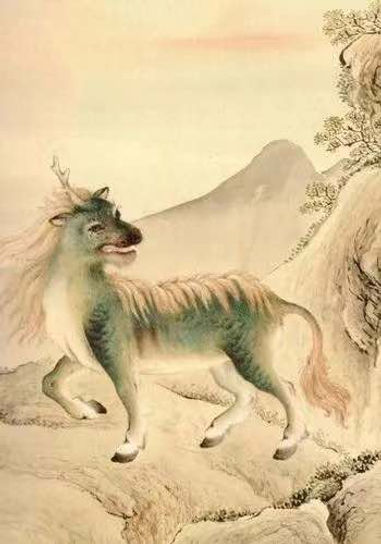
Turtle in Chinese Culture
When Yellow Emperor (Huang Di) was in a big war against another powerful clan, a turtle carrying a board with Xi Wang Mu’s magical spells came out of a river.
The magical info on this board then helped the king win the war in the end.
Turtles can live for a very long time. Therefore, they have been considered representatives of longevity, firmness, gratitude, and loyalty.
On the other hand, the various formats on turtle shells had been widely used in divination activities in ancient China, when people could read and decode the cracks after burning their shells.
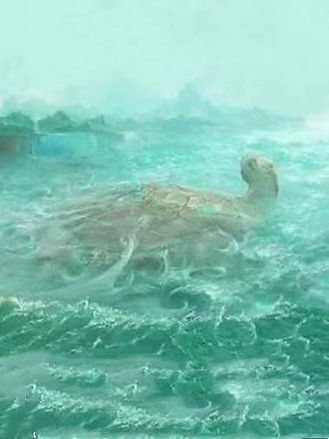
List of Other Ancient Mythical Creatures and Animals
Teng She and Bai Xi
A long time ago, Goddess Nu Wa created tens of thousands of human beings and made the world alive.
Soon, however, she felt lonely and then made two mythological creatures based on her appearance:
Teng She was a male snake who could fly, while Bai Xi was a female snake with a human top.
These two were very brave and loyal and assisted Nu Wa in defeating many other evil monsters to protect human beings.
In one version of Nu Wa's legend, she sacrificed herself to fill up the broken sky; Teng She and Bai Xi followed her and sacrificed as well.
Together, they protected human beings and brought world peace again.
In another version, Nu Wa successfully fixed the broken sky and vanished from the secular world, and Teng She and Bai Xi went with her, as always.
Later, Teng She became an essential mythical creature in the Taoism Religion's divination.
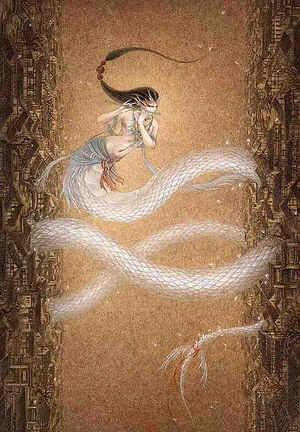
Teng She, Drawn by Shanze Li Yifan.
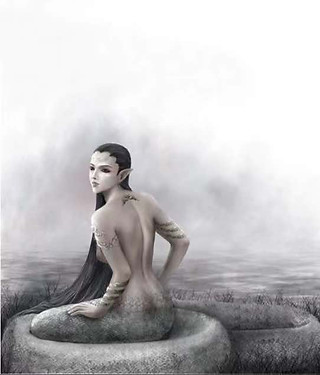
Bai Xi
Jiao Ren
Jiao Ren is a group of half-human and half-fish legendary creatures living in the South China Sea.
They are very good at weaving and can produce beautiful waterproof textiles.
Their tears are precious pearls, and their grease could burn for thousands of years.
According to some legends, inside the mysterious grave of Emperor Qin Shi Huang, which the Terra Cotta Warriors protected, many lights were made of Jiao Ren’s everlasting burning grease.
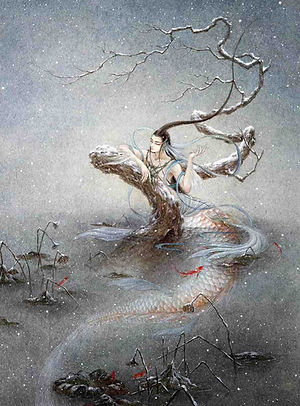
Jiao Ren, Drawn by Shanze Li Yifan.
Nine Tailed Fox or Jiu Wei Hu
Jiu Wei Hu is a fox with beautiful white fur and nine tails. They howl like newborn babies, eat people, and live in a magical place named Qingqiu.
According to some sayings in Chinese mythology, eating Jiu Wei Hu’s flesh can protect the predator from poisons.
Over 4000 years ago, Jiu Wei Hu assisted Yu the Great, the founder of the Xia Dynasty, in meeting his beloved queen. Since then, Jiu Wei Hu has represented love, happiness, and prosperity in ancient Chinese culture.
Around 1000 years ago, people started to believe that Jiu Wei Hu could transform into a beautiful woman to seduce men for different purposes.
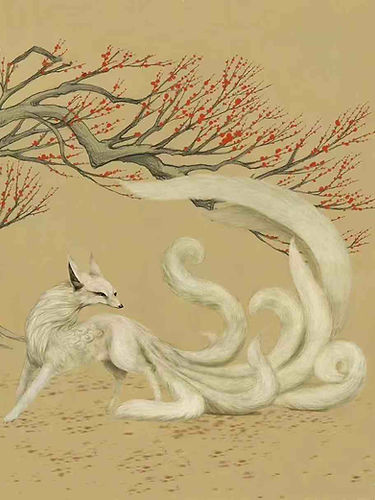
Nine-Tailed Fox, Drawn by Shi Lin.
Pi Xiu
According to Chinese mythology, Pi Xiu has a dragon’s head and tail and a lion’s body.
They fly in the sky, guarding the gates of heaven day and night.
Therefore, they are the representative of a powerful, invincible army.
Also, Pi Xiu eats everything but never excretes, which makes him respected as a wealthy patron saint in Chinese culture.
Till now, people who pray for fortune and protection will wear or set a Pi Xiu statue decoration nearby.

Gong Fu
Gong Fu is the son of a dragon and another animal, so he looks like a half-dragon and half-shrimp and can hold a large amount of water in his stomach.
Gong Fu lived in heaven in the beginning but was banished into a river and repressed under a giant turtle shell after he had made a mistake.
A thousand years later, he was released from the shell but could never return to heaven anymore. He protected humans from massive floods and evil monsters several times during this period.
Gradually, more and more people carved his image on bridges and extensive drainage systems to honor him, hoping he could continue protecting human beings.
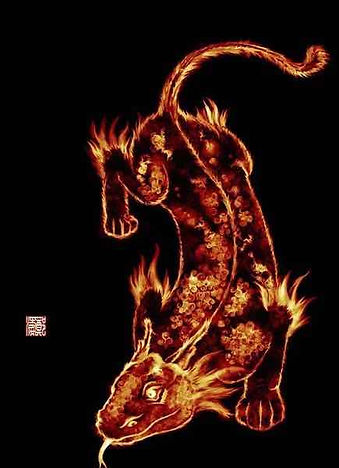
Xiang Liu
Xiang Liu, a cruel, mystical beast that fed on human flesh, had a snake’s body and nine heads. It would spray bitter, spicy, and fatal water, which turned many places into venomous and disgusting swamps.
Many people had been killed, and a large amount of land had been destroyed by its massive poisonous water.
Therefore, the founder of the Xia Dynasty, Yu the Great, killed Xiang Liu with the help of Ying Long and other dragons.
But Xiang Liu’s body and blood were still poisonous, even after it had died.
Therefore, Yu the Great buried its body in a large pond north of the mysterious Mount Kunlun and built a magical building designed to suppress and frighten other evil monsters.
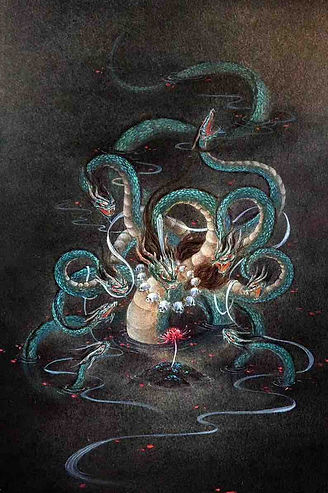
Xiang Liu, Drawn by Shanze Li Yifan
Kun Peng
Kun Peng was first documented and described by the great Taoist philosopher Zhuang Zi, or Chuang Tzu, in his masterpiece.
Kun was initially a considerable whale living in the sea, but centuries later, it transformed into an enormous bird named Peng.
The bird flew over many places and kept flying toward the mysterious holy land.
It is a purely poetic mythical creature who had never hurt or come close to humans; it only shows up occasionally near the sea throughout history.
Therefore, Kun Peng symbolizes great ambition because of its beautiful transformation and incredible journey.
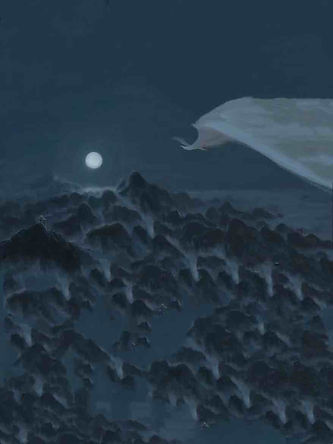
Chong Ming
Chong Ming has two eyeballs in each eye; it looks like a colorful rooster and howls like a phoenix.
In addition, it is very helpful to humans, which could scare aggressive animals and evil monsters away, using its magical howling as a weapon.
People gradually carved or painted Chong Ming’s images on roofs or doors to pray for protection.
Nowadays, some families in China still use Chong Ming’s image as a door god or decoration, praying for good luck and happiness.
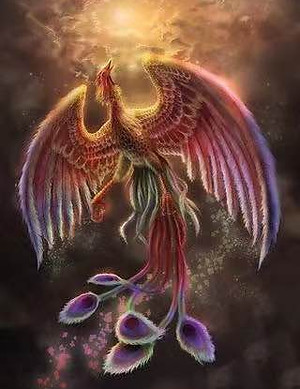
Kui
Kui is a mythical animal that was born in heaven. Kui has only one leg and howls like thunder. It can glow like sunlight and always show up along with big storms.
It is said that there were three Kuis in total. The first Kui was caught by Yellow Emperor, who made a battle drum using Kui’s skin.
The king’s enemies were seriously shocked and frightened by the sound of the drum; most of their soldiers lost their minds and then failed soon.
The second Kui was caught by Qin Shi Huang, the first emperor in the history of China who built the Great Wall and Terra Cotta Warriors.
The third and last Kui now is still unknown.

Cheng Huang
Cheng Huang looks like a white fur fox with some horns on her back.
She is mysterious and not aggressive.
If a person can ride Cheng Huang for a while, they could live for over 2000 years.
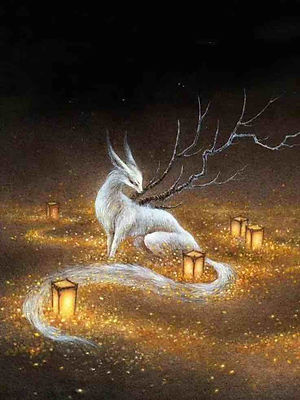
Cheng Huang, Drawn by Shanze Li Yifan.
Huo Dou
Huo Dou looks like a black dog but is much more powerful and mysterious.
Huo Dou is the assistant of the God of Fire, since it eats and excretes fire and can fire breathing.
Wherever this mythical animal appears, there will be a big fire, and many people will die.
It is said that if a piece of a meteor hits a pregnant dog on a particular day, her child will be a Huo Dou.
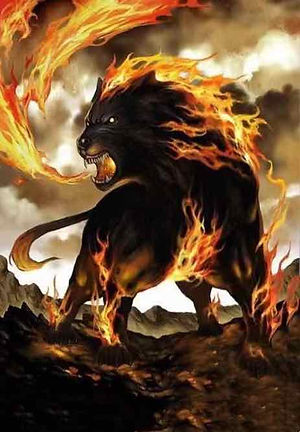
Qiong Qi
Qiong Qi is a cruel, monstrous creature who looks like a tiger with two enormous wings and is the size of a giant cow.
It feeds on humans and always starts eating from people’s heads.
He enjoys flying to places where people are fighting and bites off people’s noses who are reasonable and integrity.
Moreover, he would give animals to rude and evil people to encourage their bad behaviors.

Qiong Qi, Drawn by Shanze Li Yifan.
Zheng
Zheng lives on a vast mountain with only pine trees and hard stones.
It looks like a leopard with five tails and one strong horn.
Zheng howls like thunder and feeds on large animals like tigers or leopards.
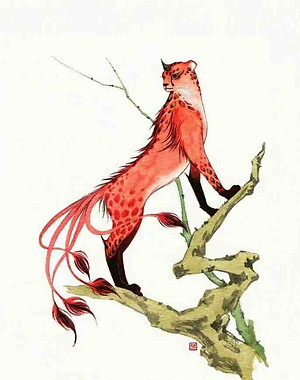
Yu Shi Qie
Yu Shi Qie lives in a state where people hold snakes in two hands and wear snakes as earrings: a cyan snake on the left ear and a red one on the right ear.

Yushiqie by Shanze Li Yifan
Shu Hu
Shu Hu lives in the mountain where the sun sets to.
It has a human’s head, snake’s tail, horse’s body, and bird’s wings.
Shu Hu never hurts people; it only likes holding people up or letting them ride on them.
Shu Hu is amiable and likes intimate contact with humans, maybe because he feels lonely sometimes.
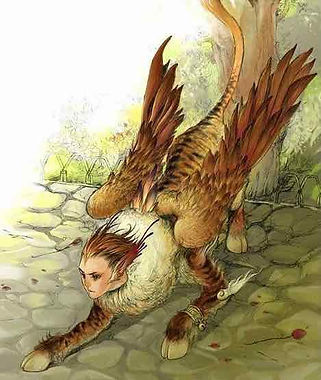
Fu Zhu
Fu Zhu looks like a big white deer with four horns.
It lives in a mountain filled with beautiful gold and jade and a vast magical pond.
Seeing Fu Zhu means a big flood will come, which makes it a mythical creature of big disasters.
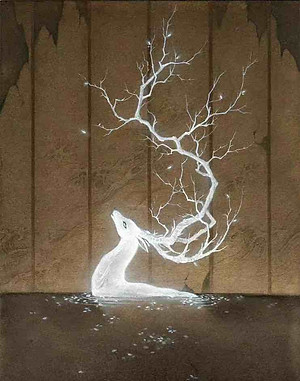
Fu Zhu, Drawn by Shanze Li Yifan.
Jiu Feng
Jiu Feng is a type of Phoenix with nine heads and colorful tails.
It is representative of luck, happiness, and prosperity in Chinese culture.
In some successful kings’ enthronement ceremonies, Jiu Feng showed up to celebrate just like an act of providence.

Fan Yu
Fan Yu is a beautiful winged horse with long, beautiful white fur, making it possible to run about 10000 miles daily and fly in the sky.
Once, Fan Yu led other horses to take King Mu of Zhou (about 1026 BC — 922 BC) to Mount Kunlun to visit the deity Xi Wangmu.
Afterward, Fan Yu became the winged horse of the sky and ride of kings only.
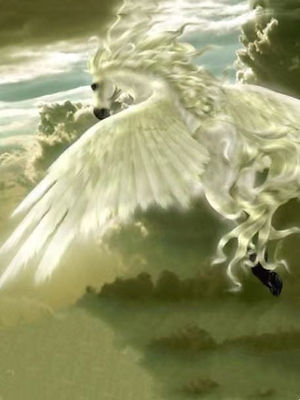
Zou Wu
Zou Wu is a very kind mystical creature with colorful patterns and a tail longer than his tiger-sized body.
Zou Wu can run thousands of miles daily and never eat live animals.
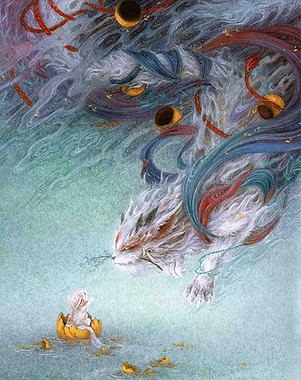
Zou Wu, by Shanze Li Yifan.
Ao Yin
Ao Yin, a monstrous creature, looks like a giant cow with four massive horns and long hair.
They were born on the darkest side of the world, ferocious, and only take human flesh as their food.

Ao Yin by Shanze Li Yifan
Di Jiang
Di Jiang lives in a mountain filled with gold, jades, and beautiful rivers.
This kind of mysterious bird, which has six feet and four enormous wings with no ear, eye, or mouth, is a professional in music and dance.
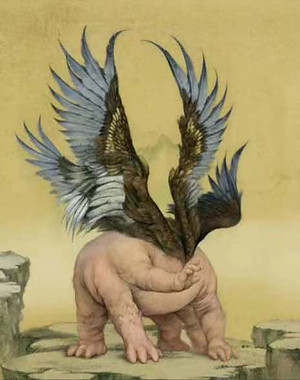
Dijiang by Shi Lin
Bi Fang
Bi Fang is the omen of the big fire, who eats nothing but fire.
It looks like a crane with one leg and a human's face, with blue leather decorated with red dots.
Wherever Bi Fang appears, there is a destructively colossal fire.

Bi Fang, Drawn by Shanze Li Yifan.
Huan Shu
Huan Shu looks like a strong horse with a longhorn.
It lives on a mountain with a large number of aquamarine jades.
Huan Shu is the enemy of fire: wherever it goes, the fire is extinguished.
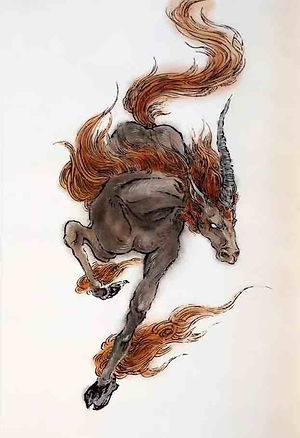
Huanshu by Shanze Li Yifan
Bi Yi
Bi Yi Bird has been the representative of great love in Chinese culture.
Bi Yi has only one eye, wing, and foot; one Bi Yi cannot fly until it finds the other perfect matchable one to fly side by side.
As long as they find each other, they will never be apart.
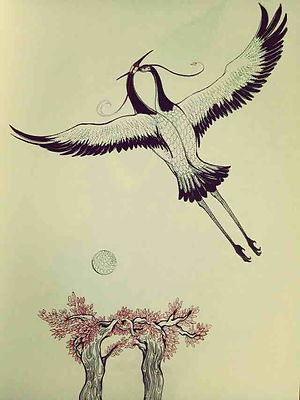
Shuang Shuang
Shuang Shuang is a mythical creature that is combined with three cyan bodies.

Shuang Shuang, by Shanze Li Yifan.
Huo Shu
Huo Shu looks like a giant mouse with over one-meter long of red fur.
Huo Shu lives in the burning forest, and it only shows up in spring and summer.
Huo Shu would die if it ran into the water, but it could live perfectly in the fire.
So its fur is precious for its silk-like and fire-proof quality.
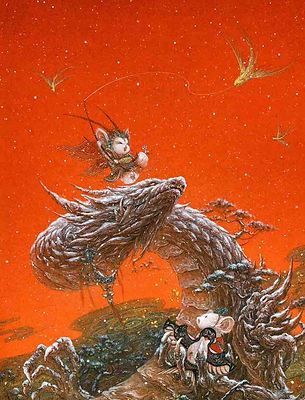
Huo Shu, Drawn by Shanze Li Yifan.
Fei
Fei was the God of Disaster.
Fei looks like an ox with a white head, one eye, and a snake’s tail. He usually lives on a mysterious mountain.
Fei would bring severe drought and plague wherever it goes.

Fei, Drawn by Shanze Li Yifan.
Heng Gong Yu
Heng Gong Yu is about 180 cm long and looks like a big carp.
They have firm skin and can stay alive even after stabbing and boiling.
But if they are boiled with two dark plums, they will die immediately.
Heng Gong Yu is a fish in the daytime but could take off the outer shell and transform into a human at night.
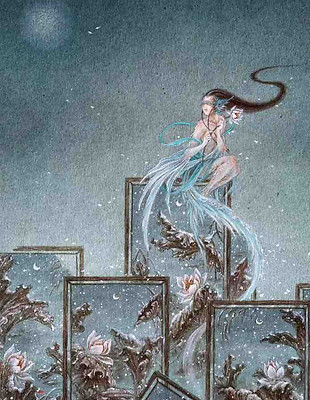
Heng Gong Yu, by Shanze Li Yifan.
Si
Si is an auspicious animal whose appearance would presage the place's prosperity and flourish in the near future.
It has an ox's huge body with one big horn and is the mount of an important Taoism deity.
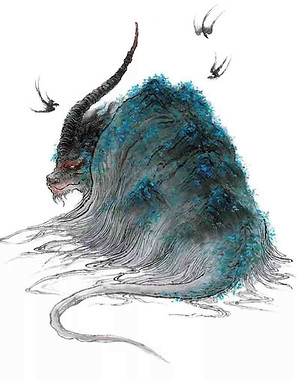
Si Drawn by Shanze Li Yifan
Fei Yi
Fei Yi lives on a barren mountain with no plants or other animals.
Fei Yi has one head and two snakelike bodies.
Wherever Fei Yi shows up, people there would suffer from severe drought.
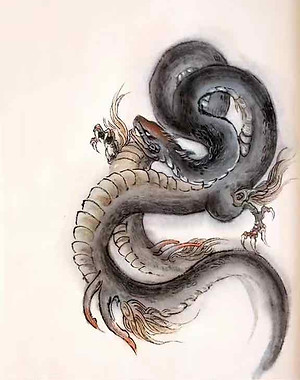
Fei Yi by Shanze Li Yifan
Zhu Nou
Zhu Nou looks like a fox with fins on his back and lives on a mountain that only grows crystal stones and giant snakes.
Wherever Zhu Nou showed up, fear spread quickly, and horrible things would happen soon.

Zhu Nou, Drawn by Shanze Li Yifan.
Lu Shu
Lu Shu looks like a horse with a white head, tiger stripe, and red tail.
Its howling sounds like humans singing folk songs.
It is believed that wearing Lu Shu’s fur could bring the best of luck to people’s offspring.
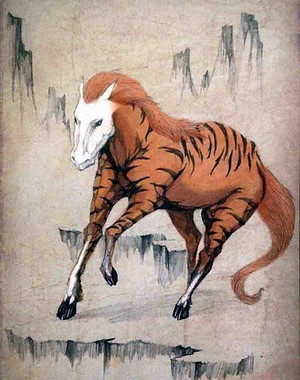
Hua She
Hua She has a human’s top, a snake’s bottom, and two wings.
She howls like a baby but barely makes sounds in everyday situations.
However, as long as she shows up and screams, the nearby places would have a big flood.
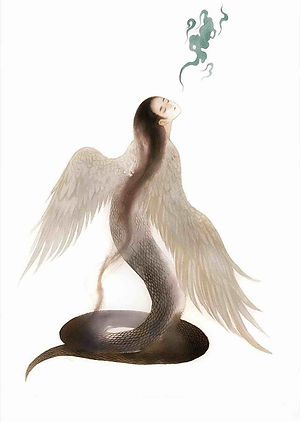_.jpg)
Hua She by Lu He
Ran Yi
Ran Yi is a fish with six feet and a snake’s head.
It lives in river outflows from a mountain where all the animals are white-colored.
Eating Ran Yi could protect people against nightmares and disasters caused by evils.

Ran Yi by Quan Gao
Xie Zhi
Xiezhi has dark and bright fur, similar in size to a cattle or sheep, often bearing a horn on its forehead, and closely resembling the auspicious creature, Qilin.
This remarkable being possesses the unique ability to swiftly identify, point out, and at times, even intervene in disputes to protect the innocent and uphold justice.
For this reason, it has become a symbol of justice and Legalism.

Xie Zhi by LiiuJiing
Yan Wei
Yan Wei looks like a giant snake with a long tail and two heads.
If a person survives after seeing Yan Wei, they could later become a king or emperor.
Therefore, many ambitious people still expect to see Yan Wei, even though it is cruel and scary.
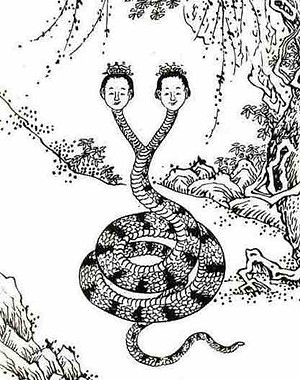
Jun Ren
Jun Ren is a tiny mythical creature with a human figure who understands humanity.
In some legends, they come from a special lilliputian.
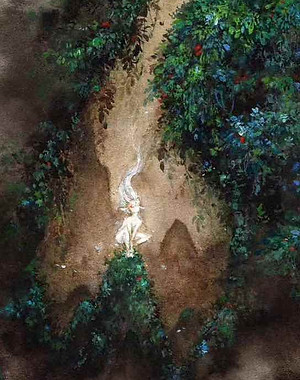
Jun Ren, Drawn by Shanze Li Yifan.
Tao Tie
Tao Tie has a goat’s body, a human’s head, a tiger’s teeth, and a human’s hands.
They were widely carved in bronze vessels over 4000 years ago in the history of China.
Tao Tie is greedy for food, and sometimes, they eat their bodies.
Therefore, Tao Tie represents avaricious and gluttonous in Chinese culture.
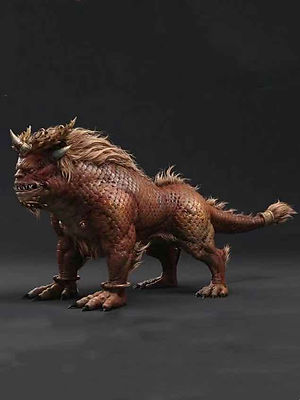
Zhu Jian
Zhu Jian has a human head with only one eye, a leopard's body, an ox's horns, and a long tail.
His long tail is in his mouth when he is walking and coils on the ground when resting.
Zhu Jian has incredibly loud sounds and is very strong. It's very talented in shooting as well.
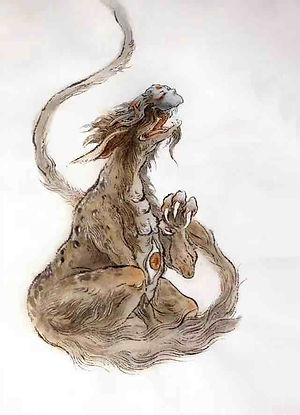
Zhu Jian, Drawn by Shanze Li Yifan.
Dang Kang
Dang Kang looks like a pig with two big ears and sharp teeth.
It is an auspicious mythical creature that only shows up in years with good harvests when calling his name "Dang Kang" and dancing happily.

Dang Kang by Shanze Li Yifan
Huan
Huan looks like a fox with only one eye and three tails, with an ear-splitting roar that can cover hundreds of other beast howls.
Huan can exorcise evils and demons, and his flesh can cure Jaundice.
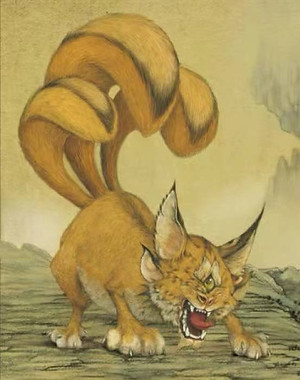
Huan by Shilin
Fei Fei
Fei Fei has the appearance of a fox, with a white-tipped tail and a mane.
Keeping it as a pet is believed to dispel worries.
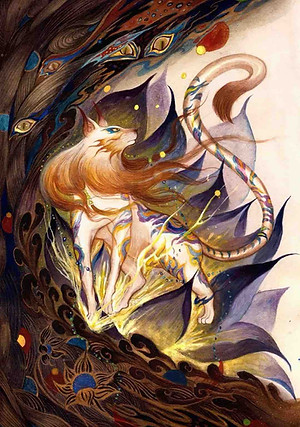
Fei Fei by Lumingshan
Tiao Yu
Tiao Yu resembles a rooster with red feathers, three tails, six legs, and four heads.
Its sound is reminiscent of the singing of magpies, and it is believed that consuming its flesh can bring about a sense of carefreeness.
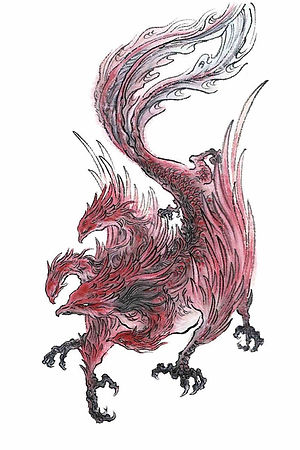
Tiao Yu by Shanze Li Yifan
Hua Yu
Hua Yu resembles a fish with wings like those of birds, emits the sound of Mandarin ducks, and radiates a brilliant light as it moves.
Its appearance is often associated with the foretelling of a worldwide drought.

Hua Yu by Aowu Xiaonainiong
Xuanyuan Guo Ren
Xuanyuan Guo Ren people have the appearance of humans with snake-like bodies, their tails intertwining with their heads.
They are generally long-lived; even the shortest-lived among them can live for over 800 years.
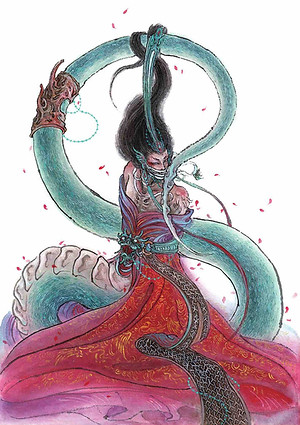
Xuanyuan Guoren by Shanze Li Yifan
Da She
Da She has a red head and a white body and produces a sound reminiscent of an ox.
Its appearance is often associated with the foretelling of a great drought in the region.
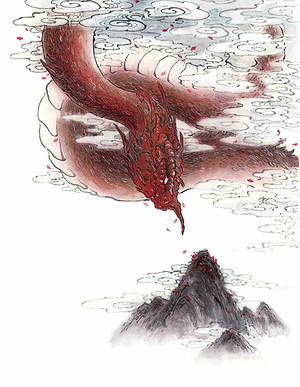
Da She by Shanze Li Yifan
Gu Huo Bird
The Gu Huo Bird only appears at night. When it dons feathers, it takes the form of a bird, but upon shedding them, it transforms into a woman.
This remarkable creature doesn't raise its own offspring; instead, it adopts the nestlings of other birds as its own.

Gu Huo Bird by Shanze Li Yifan
Cong Long
Cong Long resembles a wild goat with red fur and is sometimes believed to be a Tibetan antelope.

Cong Long by Shanze Li Yifan
Nian
In folklore, Nian is a mythical creature that might appear on Chinese New Year's Eve, and it is traditionally scared away by firecrackers, red couplets, and lanterns.
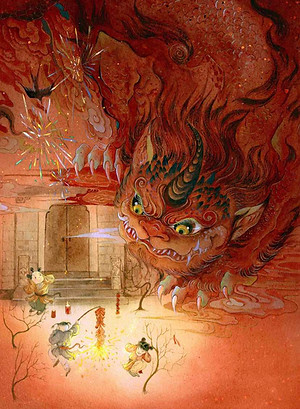
Nian by Lumingshan
Jinhua Cat
Jinhua Cat is a creature that undergoes a supernatural metamorphosis after three years of domesticity.
Each night, it ascends to the rooftop, mouth agape, savoring the moon's ethereal essence.
With newfound powers, it vanishes into the deep, secluded mountain valleys by day, reemerging only at sunset to enchant and beguile those it encounters
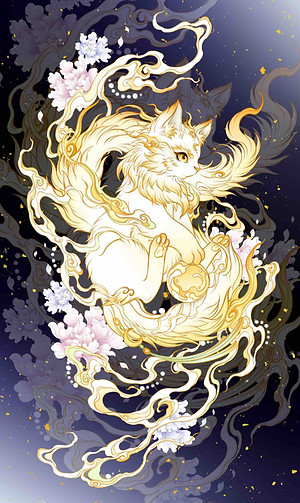
Jinhua Cat by Aowu Xiaonaixiong
White Snake
White Snake is a mythical creature with a human's upper body and a snake's lower body.
In another ancient legend, it incarnated into a beautiful woman and engaged in a romantic Love Story with a young man named Xu Xian at West Lake in Hangzhou.
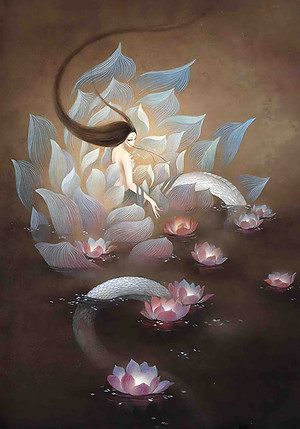
White Snake by Shanze Li Yifan
Green Snake
Green Snake, in ancient legend, incarnated into a beautiful woman after a thousand years of cultivation and ventured to the secular world at West Lake in Hangzhou.
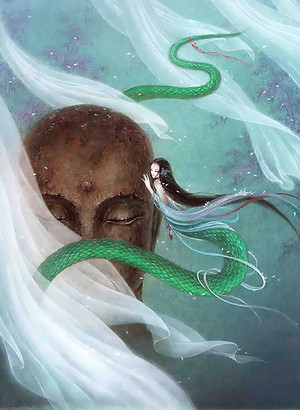
Green Snake by Shanze Li Yifan
Qing Luan
Qing Luan is a type of Chinese Phoenix Fenghuang, whose predominant color is cyan.
In some legends, it is believed to be the messenger of the Goddess Xiwangmu.
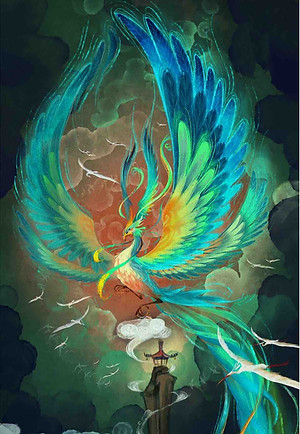
Qing Luan by Dongcheng Zhangsanye
You Might Also Like:
Mythical Beings: Soul, Spirit, Demon, Monster, Ghost, Devil, Deity, and God
Chinese Dragon or Loong — History, Power, Utilization, and Culture
The Nine Sons of the Dragon — An Ultimate Guide
Chinese Phoenix Fenghuang — Legend, History, Utilization, and Culture
The Five Types of the Fenghuang — Legends, Symbolism, and Influence
The Nine Sons of the Chinese Phoenix Fenghuang — An Ultimate Guide
Qilin — Mythical Creature of Benevolence, Strength, and Auspiciousness
Nine-Tailed Fox, Huli Jing, and Fox Spirit in Chinese Culture
Mythical Places in Chinese Mythology, Folklore, and Legends
Ancient Creation Myth and Chinese Gods
Chinese Goddesses in Creation Myths and Legends, Religions, and Folklore
Mythical Deities in Chinese Mythology, Folklore, and Legends
Prehistoric Heroes and Apotheosized Kings
Chinese Mythology — Origins, Characteristics, Folklore, Legends, and Elements
Yin Yang and Taiji — Origin, Meaning, Symbol, and Utilization
Chinese Zodiac Signs — A Comprehensive Introduction
Chinese Astrology — Three Enclosures, Four Symbols, Twenty-eight Lunar Mansions
































